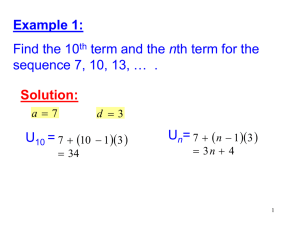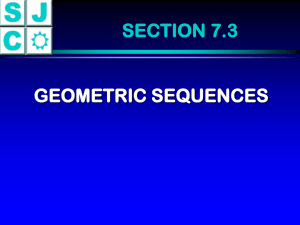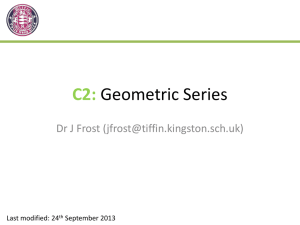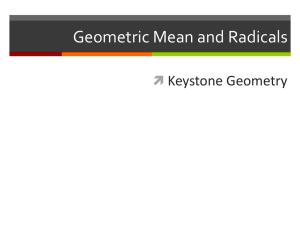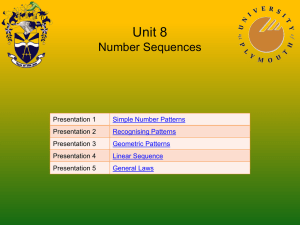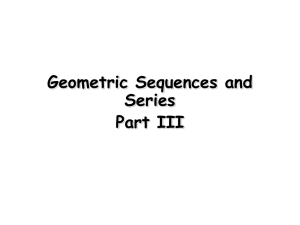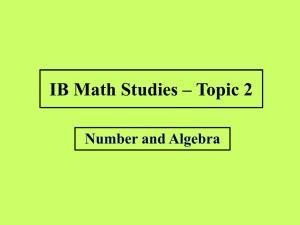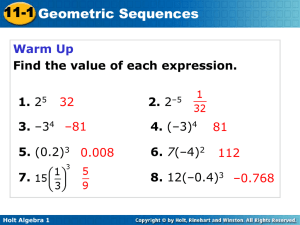Week_3_-_Sum_of_a_Geometric_Series
advertisement
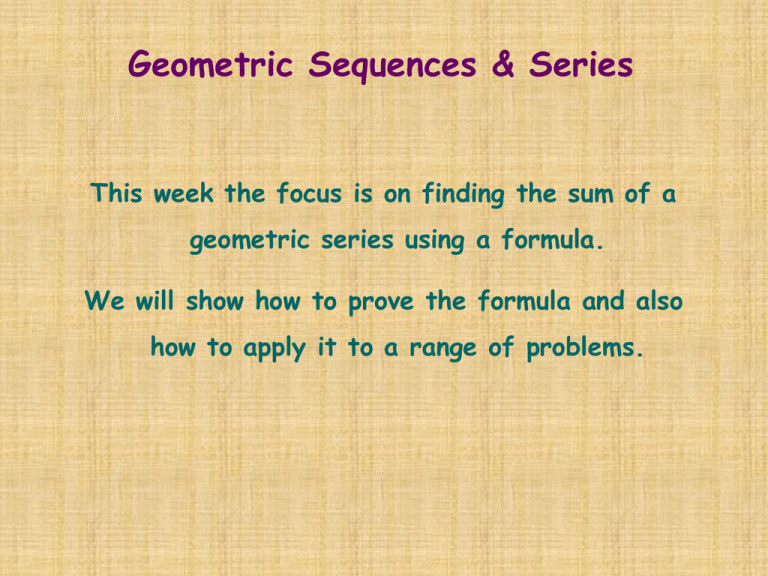
Geometric Sequences & Series This week the focus is on finding the sum of a geometric series using a formula. We will show how to prove the formula and also how to apply it to a range of problems. Geometric Sequences & Series CONTENTS: Sum of a Geometric Series Proof of Sum Formula Example 1 Example 2 Example 3 Example 4 Assignment Geometric Sequences & Series Sum of a Geometric Series To find the sum of a geometric series we use a formula: a(rn – 1) Sn = --------- (if r > 1) r - 1 or a(1 - rn) Sn = --------1 - r (if r < 1) Geometric Sequences & Series Sum of a Geometric Series – Proof Sn = a + ar + ar2 + ar3 + ... + arn-1 (1) rSn = ar + ar2 + ar3 + ar4 + ... + arn (2) Subtracting (1) and (2) gives: Sn – rSn = a – arn all but the first and last terms cancel out Sn(1 – r) = a(1 - rn) factorise out Sn Sn = a(1 – rn) / (1 – r) bring the (1 – r) to the other side Geometric Sequences & Series Example 1: Find the sum of the geometric series: 1 + 2 + 4 + 8 + ... (8 terms) Solution: To use the Sum formula we need to work out a, r and n. a = 1 r = 2/1 = 2 n = 8 As r > 1 we will use the formula Sn = a(rn – 1)/ (r – 1) Substituting into the formula gives: S8 = 1(28 – 1)/ (2 – 1) S8 = 1(256 – 1)/ (1) S8 = 255 Geometric Sequences & Series Example 2: r 10 1 Work out 6 2 r 1 Solution: Remember Σ means sum. So we are trying to find the sum of a series. Work out the first few terms of the series but substituting in r = 1, r = 2, r = 3 to get: 6 x (½)1 + 6 x (½)2 + 6 x (½)3 + ... = 6[(½) + (½)2 + (½)3 + ...] (½) + (½)2 + (½)3 + ... is a geometric series with a = ½ r = ½ We have 10 terms as we want the sum from r = 1 to r = 10. Therefore n = 10 continued on next slide Geometric Sequences & Series We then have a = ½ , r = ½ and n = 10 a(1 r n ) We substitute into the sum formula Sn because r < 1 r 1 and we will need to multiply our answer by 6. 1 1 10 1 2 2 Sn 6 1 1 2 1 1 1 2 1024 6 1 2 1 1023 2 1024 1023 6 6 5.994 1 1024 2 Geometric Sequences & Series Example 3: Jane invests £4000 at the start of every year. She negotiates a rate of interest of 4% per annum, which is paid at the end of the year. How much is her investment worth at the end of the 10th year? Solution: Let a be the initial investment. This gives a = 4000. The rate of interest is 4% p.a therefore r = 1.04. End of Year 1: Start of Year 2: End of Year 2: 4000 x 1.04 4000 x 1.04 + 4000 (4000 x 1.04 + 4000) x 1.04 = 4000 x 1.042 + 4000 x 1.04 = 4000(1.042 + 1.04) continued on next slide Geometric Sequences & Series If we continue this pattern we get: 4000(1.0410 + 1.049 + 1.048 + ... + 1.04) 1.0410 + 1.049 + 1.048 + ... + 1.04 is a geometric series with a = 1.04, r = 1.04 and n = 10. We can find the sum of this series using our sum formula and multiplying the answer by 4000 to get the total worth of the investment at the end of the 10 years. continued in next slide Geometric Sequences & Series 1.04 1.0410 1 S10 4000 1.04 1 1.040.4802442849 4000 0.04 0.4994540563 4000 49945.41 0.04 At the end of 10 years Jane’s investment is worth £49 945.41 Geometric Sequences & Series Example 4: Find the least value of n such that the sum 5 + 4.5 + 4.05 + ... to n terms would first exceed 45. Solution: This question is asking us to find n such that Sn > 45. From the question we see that a = 1 and r = 4.5/5 = 0.9. We can substitute these values into the sum formula to get an inequality in n to solve. continued in next slide Geometric Sequences & Series 51 - (0.9)n 45 1 - 0.9 Substituting the known values into the sum formula and letting it be > 45. 51 - (0.9)n 45 0.1 5(1 (0.9)n ) 4.5 Multiplying across by 0.1 1- (0.9)n 0.9 Divide across by 5 - (0.9)n - 0.1 (0.9)n 0.1 nlog(0.9) log (0.1) n 21.85 Take logs of both sides and bring power of n forward This implies that when n = 22 the sum of the series will first exceed 45. Geometric Sequences & Series ASSIGNMENT This weeks assignment is in Moodle. There are 5 questions to answer. Deadline for submitting assignments is 5:00pm on Monday 29th March.

